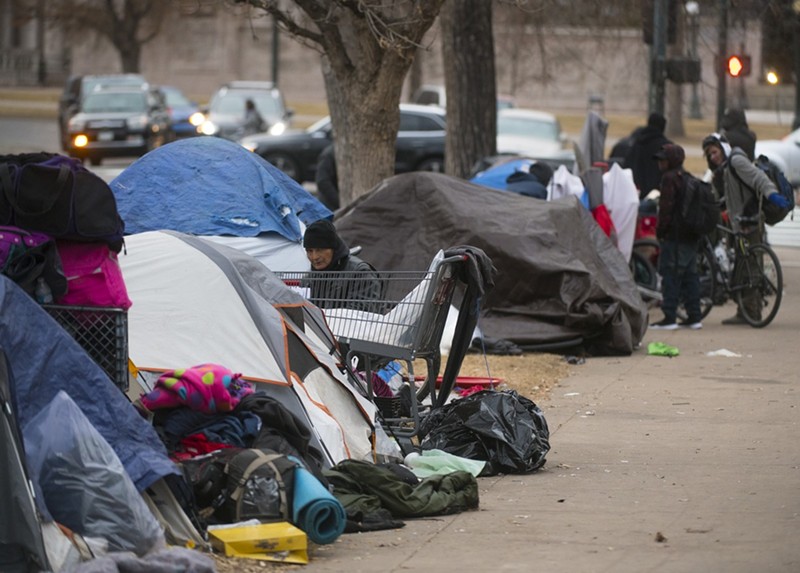On August 5, the Common Sense Institute, a Colorado "free enterprise" think tank, released "The Economic Footprint of Homelessness in Metro Denver," a report that suggested that governmental, quasi-governmental and nonprofit entities spend an estimated $434.6 million annually on homelessness in the Denver area.
"We really can do better. We can get more results and we can definitely have a bigger impact than we are, and that's the goal here," Mike Zoellner, who served as the finance chair of the Together Denver campaign that fought against a ballot initiative seeking to decriminalize homelessness in 2019, said at a gathering announcing the results.
The report received local and even national coverage. Fox News published an article on August 5 that said, "Denver spends far more on homelessness per person than K-12 students, veterans affairs."
But local service providers and a national advocacy organization argue that the Common Sense report is inaccurate and misleading.
"The Metro Denver Homeless Initiative identified several limitations and inaccuracies which were the basis of this report to the researchers during the design phase of this report. However, the researchers chose to move forward fully aware of these limitations, which led to MDHI’s decision to not participate," Matt Meyer, executive director of MDHI, says in an open letter released August 17 that lists six perceived inaccuracies in the CSI report.
For example, the "per person cost in excess of $104,000 in Denver and $78,000 throughout the region is a misrepresentation. The authors divided their calculated annual cost by the number of people experiencing homelessness on a single night. This created a grossly inflated cost which is misleading," the MDHI letter states.
Additionally, MDHI says, the "comparison to spending in other sectors contains glaring errors," among them that "with education spending, the report limited the cost of education to government spending and does not include nonprofits serving the educational needs of students, volunteer hours, nor healthcare costs such as school-based health centers and other medical services provided to students. Yet, these types of costs are included in the $481 million the report claims in spending on homelessness. These two numbers cannot and should not be compared."
The National Homeless Information Project released its own statement claiming that the study's "interpretation of these numbers is wrongheaded." Among the points that the NHIP disputes is how "an estimate of $175 million for health care for homeless persons (about 40 percent of the total) is treated as if it is an outcome of the current homeless service system."
Instead, NHIP argues, "The city would have these costs or more regardless of whether homeless services were funded. It is essentially the cost of indigent health services. Even conservative estimates of [permanent supportive housing] costs show that savings are likely equal to the cost of allowing many unsheltered persons to live on the streets."
But CSI has come out swinging against the critics of its study.
“The statement released by MDHI questioning the findings of this study is not about facts, economics or fiscal policy. It is fiction,” Kristin Strohm, president of the Common Sense Institute, says in a release responding to the MDHI arguments.
CSI calls the MDHI challenge a "clear example of pettiness and obstructionism during a time where we most need collaboration and partnership."
CSI takes issue with MDHI's specific criticisms, including the use of the Point in Time count in calculating costs.
"CSI used this data because MDHI, as the Continuum of Care agency, does not provide an annual average estimate," the CSI statement says. "However, because it is only one night of the year, CSI used a higher estimate of 2.5X the PIT figure to provide a range, which is what the Colorado Coalition of the Homeless and many other organizations use. The range of data is clearly explained in the paper as starting with the PIT count and ending with the annual estimate."
But the Colorado Coalition for the Homeless doesn't support the report, particularly since it came "on the heels of the Social Impact Bond report," according to the organization's Cathy Alderman. The Social Impact Bond report, which was released in July, showed that the housing-first model has been extremely successful when implemented in Denver.
The Homeless Leadership Council, which comprises the main homeless service providers in Denver, asked that its name be removed from the CSI report. Alderman says the report "gives people this picture of the homelessness response system in Denver that's completely inaccurate."
The report was only the first phase of CSI's study of homeless service providers in metro Denver. The second phase will involve researchers looking at what works and what doesn't, while the third phase will include the introduction of an online data dashboard.
"If those phases are based on phase one, which is deeply flawed," says Alderman, "we're just kind of reticent about what to expect next."
[
{
"name": "Air - MediumRectangle - Inline Content - Mobile Display Size",
"component": "12017618",
"insertPoint": "2",
"requiredCountToDisplay": "2",
"watchElement": ".fdn-content-body",
"astAdList": [
{
"adType": "rectangle",
"displayTargets": "mobile"
}
]
},{
"name": "Editor Picks",
"component": "17242653",
"insertPoint": "4",
"requiredCountToDisplay": "1",
"watchElement": ".fdn-content-body",
"astAdList": [
{
"adType": "rectangle",
"displayTargets": "desktop|tablet"
},{
"adType": "rectangle",
"displayTargets": "desktop|tablet|mobile"
}
]
},{
"name": "Inline Links",
"component": "18838239",
"insertPoint": "8th",
"startingPoint": 8,
"requiredCountToDisplay": "7",
"maxInsertions": 25
},{
"name": "Air - MediumRectangle - Combo - Inline Content",
"component": "17261320",
"insertPoint": "8th",
"startingPoint": 8,
"requiredCountToDisplay": "7",
"maxInsertions": 25,
"watchElement": ".fdn-content-body",
"astAdList": [
{
"adType": "rectangle",
"displayTargets": "desktop|tablet"
},{
"adType": "rectangle",
"displayTargets": "desktop|tablet|mobile"
}
]
},{
"name": "Inline Links",
"component": "18838239",
"insertPoint": "8th",
"startingPoint": 12,
"requiredCountToDisplay": "11",
"maxInsertions": 25
},{
"name": "Air - Leaderboard Tower - Combo - Inline Content",
"component": "17261321",
"insertPoint": "8th",
"startingPoint": 12,
"requiredCountToDisplay": "11",
"maxInsertions": 25,
"watchElement": ".fdn-content-body",
"astAdList": [
{
"adType": "leaderboardInlineContent",
"displayTargets": "desktop|tablet"
},{
"adType": "tower",
"displayTargets": "mobile"
}
]
}
]












